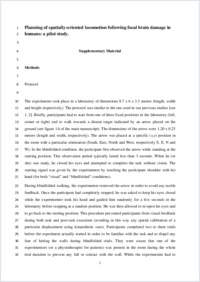Planning of spatially-oriented locomotion following focal brain damage in humans: A pilot study
- Hicheur, Halim Unit of Sport and Movement Sciences, Dept. of Medicine, University of Fribourg, Switzerland
- Boujon, Carole Unit of Sport and Movement Sciences, Dept. of Medicine, University of Fribourg, Switzerland
- Wong, Cuebong School of Mechanical and Aerospace Engineering, Nanyang Technological University, Singapore
- Pham, Quang-Cuong School of Mechanical and Aerospace Engineering, Nanyang Technological University, Singapore
- Annoni, Jean-Marie Neurology unit, Dept. of Medicine, University of Fribourg, Switzerland
- Bihl, Titus Neurorehabilitation Unit, Hôpital Fribourgeois (HFR), Switzerland
-
15.03.2016
Published in:
- Behavioural Brain Research. - 2016, vol. 301, p. 33–42
English
Motor impairments in human gait following stroke or focal brain damage are well documented. Here, we investigated whether stroke and/or focal brain damage also affect the navigational component of spatially oriented locomotion. Ten healthy adult participants and ten adult brain-damaged patients had to walk towards distant targets from different starting positions (with vision or blindfolded). No instructions as to which the path to follow were provided to them. We observed very similar geometrical forms of paths across the two groups of participants and across visual conditions. This spatial stereotypy of whole-body displacements was observed following brain damage, even in the most severely impaired (hemiparetic) patients. This contrasted with much more variability at the temporal level. In particular, healthy participants and non-hemiparetic patients varied their walking speed according to curvature changes along the path. On the contrary, the walking speed profiles were not stereotypical and were not systematically constrained by path geometry in hemiparetic patients where it was associated with different stepping behaviors. These observations confirm the dissociation between cognitive and motor aspects of gait recovery post-stroke. The impact of these findings on the understanding of the functional and anatomical organization of spatially-oriented locomotion and for rehabilitation purposes is discussed and contextualized in the light of recent advances in electrophysiological studies.
- Faculty
- Faculté des sciences et de médecine
- Department
- Médecine 3ème année
- Language
-
- English
- Classification
- Biological sciences
- License
-
License undefined
- Identifiers
-
- RERO DOC 258897
- DOI 10.1016/j.bbr.2015.12.014
- Persistent URL
- https://folia.unifr.ch/unifr/documents/304825
Other files
Statistics
Document views: 107
File downloads:
- pdf: 219
- Supplementary material: 115

